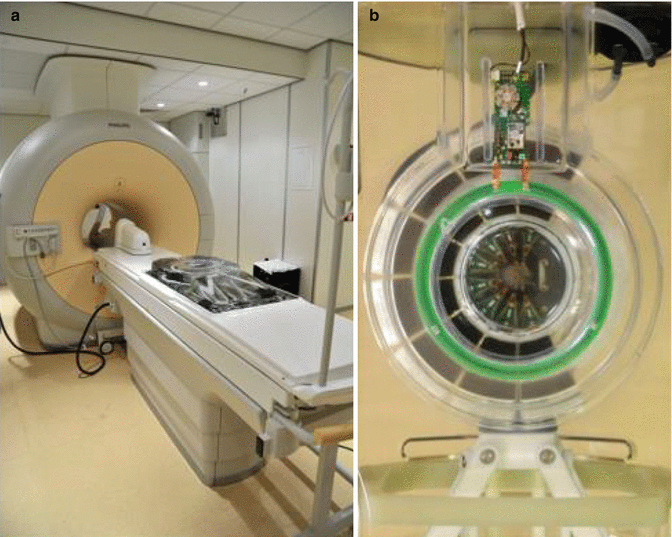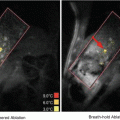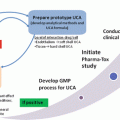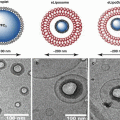Fig. 4.1
Dynamic contrast-enhanced bilateral 3 T MRI with fat suppression showing a mass in the right breast with an irregular enhancement pattern (a). The lesion has suspect enhancement kinetics with rapid wash-in followed by washout in the delayed phase (b)
4.2.2 MRI for Guidance of HIFU Treatment
MRI has different roles with regard to treatment. Firstly, it is a tool for patient selection. The size of the tumor, the distance to the skin and pectoral muscle and the position in the breast can be accurately determined (Peters et al. 2008; Blair et al. 2006). These factors should be investigated beforehand to assess whether a patient is eligible for MR-HIFU treatment. Besides, MRI frequently detects additional lesions that are occult on conventional imaging, altering the eligibility for MR-HIFU treatment and possibly even changing the surgical therapy (Houssami et al. 2008).
Secondly, MRI is useful for guidance during HIFU treatment for several reasons. Foremost, it provides accurate anatomic details of the tumor and surrounding tissue, enabling precise treatment planning. Additionally, MRI provides real-time temperature maps. Monitoring the temperature in the breast during HIFU treatments is of utmost importance as it shows whether the target temperature of more than 60 °C is reached at the treatment site. Consequently, treatments can be adjusted when necessary. The most widely used thermometry method is proton resonance frequency shift (PRFS) (Zippel and Papa 2005; Furusawa et al. 2006). This technique is discussed in Sect. 5.5.2.
Lastly, MRI can be used after treatment for the assessment of treatment results. Since MR-HIFU ablation is a non-invasive technique, reliable imaging methods are a prerequisite for clinical implementation of MR-HIFU ablation in order to detect eventual residual disease. MRI can accurately depict the amount of coagulated tissue (Hynynen 2010). The most reliable method is T1-weighted contrast-enhanced MR imaging. The coagulated area is seen as a hypointense mass due to the cessation of blood perfusion (McDannold et al. 1998). Gianfelice and Khiat et al. investigated the value of three dynamic contrast enhanced-MRI (DCE-MRI) parameters and found correlations with the percentage of residual tumor. These correlations are most likely based on the decrease of microvessel density after ablation. The reliability of DCE-MRI was dependent on the time-interval between MR-HIFU and imaging, correlation coefficients clearly improved after 7 days when compared to imaging directly after treatment (Gianfelice et al. 2003a; Khiat et al. 2006).
4.3 High Intensity Focused Ultrasound of the Breast
4.3.1 Technique
The HIFU technique is already described in detail in Chap. 1 of this book. In summary, MR-HIFU ablation is an entirely non-invasive technique which makes use of ultrasound beams that are focused in a focal point. Due to the high intensity of the focused ultrasound beam, the temperature in the focal point increases rapidly. The amount of heating depends mainly on the applied power and the perfusion of the targeted tissue. The more perfusion, the less heating will occur as the blood flow distributes the heat away from the focal point. Due to the precise targeting with MRI-guidance, the adjacent healthy tissue and the skin remain unaffected. If a temperature of at least 57–60 °C is reached for a few seconds, protein denaturation occurs, leading to tissue necrosis. Lower temperatures for a longer period of time can also induce tissue necrosis (Jenne et al. 2012; Jolesz 2009; Hynynen 2010).
The size of the focal point depends on characteristics of the transducer that produces the ultrasound beams. The focal point is usually too small to totally ablate a tumor in one sonication (Haar and Coussios 2007). Ablation of large volumes is either done by “the point-by-point method” or by a “volumetric heating method” (Voogt et al. 2012; Kohler et al. 2009). With the point-by-point method, separate points are consecutively heated forming a grid of ablations. A limitation of this technique is the cooling time between the separate sonications that has to be taken into account, enabling diffusion of deposited energy. This makes MR-HIFU treatments relatively time consuming. Volumetric heating is performed by steering the focal point along outward moving trajectories, using the previous heat buildup in the center of the tumor. A larger tissue volume is ablated per sonication, resulting in shorter treatment durations (Fig. 4.2) (Kohler et al. 2009; Salomir et al. 2000; Voogt et al. 2012).


Fig. 4.2
Schematic outline of the volumetric ablation technique
4.3.2 HIFU Breast Systems
Two different types of MR-HIFU systems exist. The most important difference between both systems is the targeting approach. The “fibroid platform”, or “generic” approach, is currently most widely used. With this type of system, the breast is targeted from an anterior direction (Fig. 4.3a).


Fig. 4.3
Two approaches of HIFU ablation of the breast. Generic approach (a), Dedicated approach (b)
The transducer is immersed in a water bath, which is embedded in an MRI tabletop. The shape of the transducer is spherical to enable focusing of the ultrasound beam. In most centers that perform clinical studies MR-HIFU breast studies, the ExAblate 2000, produced by InSightec (Haifa, Israel) has been used (Gianfelice et al. 2003b; Furusawa et al. 2006). Another system that provides anterior sonications has also been used (Hynynen et al. 2001; Cline et al. 1995).
More recently, systems using a “dedicated approach” have been developed. The main difference with the generic approach is the direction of the HIFU beam. The ultrasound transducers are positioned around the breast, allowing for lateral sonications (Fig. 4.3b). In 2001, the first patient was treated with a dedicated breast system in a feasibility study (Huber et al. 2001). Other breast-specific systems have been developed by different research groups. Payne et al. introduced a 256-element phased-array transducer, which can be moved around the breast (Payne et al. 2012). In-vivo experiments in a goat udder model demonstrated that this MR-HIFU system was able to effectively and safely perform ablations (Payne et al. 2013). Currently, a dedicated breast system (Sonalleve, Philips Healthcare, Vantaa, Finland) is used in clinical feasibility and efficacy studies in the University Medical Center of Utrecht, the Netherlands (see Sect. 4.6). The transducer of this system consists of eight modules with 32 elements each, submerged in degassed water. The transducer is circumferentially positioned around a breast cup, which is positioned in the middle of an MRI tabletop (Fig. 4.4) (Moonen and Mougenot 2006; Merckel et al. 2013).


Fig. 4.4
Dedicated breast system with tabletop integrated in 1.5 T MRI scanner (a) and a close-up of the breast cup with eight circumferentially positioned transducers (b)
An important benefit of the dedicated, lateral approach is the distance between the focus and the rib cage and heart and lungs. The area behind the focal point, where the ultrasound beam diverges, is called the far field of the beam path. During MR-HIFU treatments, a risk of overheating is caused by energy deposition of the far-field beam in the rib cage, heart and lungs. The effective distance between the focal point and the structures in the far field is larger with the dedicated approach when compared to the anterior approach. Besides, not the entire far-field beam will reach the ribcage, heart and lungs because it leaves the breast on the opposite side of the transducer due to its horizontal orientation. As a result, the risk of overheating the far field is reduced. Furthermore, the aforementioned dedicated breast system contains eight transducer modules which all reach the breast from a slightly different direction. The energy density at the skin level is therefore decreased compared to systems with a single transducer, reducing the risk of skin burns (Merckel et al. 2013). A possible disadvantage of this wide aperture system is focus aberration due to heterogeneous breast tissue. The breast contains fibroglandular and adipose tissue in which the speed of sound is different. The ultrasound beams from different directions therefore have different acoustic paths. In very large, heterogeneous breasts this might lead to clinically relevant focus aberration. Mougenot et al. have investigated a correction method to mitigate distortion of the focal point during treatments (Mougenot et al. 2012).
4.4 Clinical Studies
4.4.1 Benign Lesions
In 2001, the first application for MR-HIFU ablation of benign lesions in the breast was reported. Nine patients with 11 fibroadenomas underwent MR-HIFU ablation in a feasibility study. They received local anesthesia injected behind the fibroadenoma. Eight tumors showed partial (50–90 %) or complete (>90 %) response, indicated by the size of non-perfused volumes on MRI. Follow-up MRI scans at 6 months showed a significant decrease in tumor volume of 0.6 cm3 on average. The lesions felt softer on physical examination, which was also reported by the patients. Non-effectiveness of MR-HIFU ablation was attributed to insufficient energy deposition in the tumor in one patient, and to patient movements in two other patients. In one patient, an analgesic was injected in front of the fibroadenoma, causing scattering of the ultrasound and therefore no sufficient heating of the tumor. This study also showed a number of side effects that are known to occur after HIFU ablation. One patient had post-procedural edema in the pectoral muscle. However, no clinical consequences were observed and the edema disappeared within 14 days. One patient developed a bruise on the skin. Four patients experienced mild pain during treatment, two patients moderate pain and one patient severe pain. Breast tenderness lasted up to 10 days in some cases. Finally, transient moderate swelling of the treated breast was observed. No long-term side effects occurred (Hynynen et al. 2001).
4.4.2 Invasive Breast Cancer with Resection
The first-in-man study in patients with benign tumors was followed by various studies in patients with invasive breast cancer. The majority of MR-HIFU breast studies were performed according to a treat-and-resect protocol to facilitate histologic evaluation of the treatment response. Huber et al. reported the first results of MR-HIFU ablation of invasive breast cancer. They treated one patient who underwent breast-conserving surgery 5 days later. Post-therapeutic MR imaging showed a lack of contrast uptake in the treated region, indicating that the tumor was successfully ablated. Furthermore, a hyperintense rim surrounding the tumor was seen. Histopathology demonstrated sublethal and lethal thermal damage in the tumor (Huber et al. 2001). Gianfelice et al. performed MR-HIFU ablation in 12 patients. Only in two patients complete necrosis of the tumorous tissue was achieved. They used two different focused US systems, of which the second performed better. An average of 43.3 % of malignant tissue was ablated with the first system in three patients. The second system provided tumor necrosis in 88.3 % in nine patients. All patients experienced slight to moderate pain during the treatments, despite administration of analgesics (fentanyl citrate) and sedatives (midazolam) in variable doses. The pain or discomfort was transient in all cases. The most important side effects were second-degree skin burns in two patients (Gianfelice et al. 2003b). In the same year, Gianfelice et al. reported results of 17 breast cancer patients treated with MR-HIFU, also partly included in their previous paper (Gianfelice et al. 2003b). This study was designed to investigate the role of DCE-MRI in assessing the amount of residual disease after MR-HIFU. In four patients, total tumor necrosis was found under histopathological evaluation, more than 90 % of the tumor was ablated in nine patients and four patients had necrotic volumes ranging from 25 to 70 % (Gianfelice et al. 2003a). Khiat et al. used the same patient population and added extra patients; they reported the results of the treatments of 25 women in total. The focus of this paper was the effect of the duration between HIFU treatment and MRI performance on MRI parameters that are used to assess the presence of residual tumor. A total of 26 tumors were treated, of which seven were found to be totally ablated. Another seven tumors were 10–80 % ablated, the remaining tumors showed less than 10 % residual disease. Contrast-enhanced MRI parameters were most reliable when assessed after 7 or more days after HIFU. When MRI was performed directly after treatment, no conclusions about treatment efficacy could be drawn (Khiat et al. 2006). In 2005, another phase one trial was conducted in ten patients with early stage breast cancer. MR-HIFU ablation was 100 % effective in two patients. The amount of residual disease in the other eight patients ranged from 30 % to only microscopic foci (Zippel and Papa 2005). Furusawa et al. treated 30 breast cancer patients with MR-HIFU ablation. Complete necrosis of the tumor was seen in 15 of 30 patients (50 %). The amount of necrotic tumor exceeded 85 % in 28 patients (Furusawa et al. 2006). Finally, an Italian MR-HIFU study is currently being performed. Preliminary results from 2013 show that in nine out of 10 treated patients, complete tumor necrosis, including a margin of 5 mm, was achieved (Napoli et al. 2013).
Adverse events occurred in many patients, but were usually mild. The majority of patients experienced mild pain, discomfort or a pressure sensation during the treatments (Huber et al. 2001; Furusawa et al. 2006; Zippel and Papa 2005). In some cases, some breast tenderness lasted for a few days (Gianfelice et al. 2003b). Another common side effect is skin burns, which were reported in four patients in three studies. One of these patients had a third-degree skin burn, the only reported major adverse event (Furusawa et al. 2006; Gianfelice et al. 2003b; Zippel and Papa 2005). The occurrence of long-term side effects could not be investigated in these studies as a result of subsequent surgical resection of the treated tumors. Generally, few complications occur after MR-HIFU treatment, especially when safety margins are taken into account.
MR-HIFU ablation was not equally successful in all patients. Several reasons for treatment failure have been mentioned. In most cases, insufficient power was delivered to the tumor. In one patient, the skin absorbed an abnormal amount of energy, hampering lethal heating of the tumor (Furusawa et al. 2006). In some studies, patients received local anesthesia that was injected behind the tumor (Furusawa et al. 2006). Another anesthesia method was intravenous administration of an opioid with a sedative (Gianfelice et al. 2003b) or just an oral sedative (Huber et al. 2001). Generally it seems that local analgesia or conscious sedation is not always sufficient during MR-HIFU treatments. Patients still experience pain or move, which makes accurate targeting difficult. Tumor targeting was often poor, indicating that careful patient selection is important and that technical problems still have to be solved (Gianfelice et al. 2003b). Furthermore, a large enough margin around the tumor should be taken into account (Gianfelice et al. 2003b).
4.4.3 Invasive Breast Cancer Without Resection
Gianfelice et al. also assessed the feasibility and efficacy of MR-HIFU ablation in breast cancer patients who did not undergo surgical excision after HIFU treatment. These patients were either at high risk for surgical complications or refused surgery. Twenty-four patients with biopsy-proven breast cancer received Tamoxifen as a primary treatment and underwent ‘adjuvant’ MR-HIFU ablation. All patients were free of metastases at the start of the study. The effectiveness of MR-HIFU ablation was assessed by multiple biopsies in different areas of the tumor after one or two treatments. After the first treatment, core biopsies were negative in 58.3 % (14 patients). A second MR-HIFU procedure yielded five more tumor free patients, increasing the total number of successful treatments to 19 (79 %). No patients developed metastases during a mean follow-up of 20.2 months (range 12–39 months). All patients reported mild to moderate pain during treatment and one patient was found to have a second-degree skin burn after treatment. It should be mentioned that patients undergoing MR-HIFU ablation had already been receiving Tamoxifen therapy for variable periods of time. Therefore, the treatment results cannot be entirely attributed to MR-HIFU ablation (Gianfelice et al. 2003c).
The most recently published MR-HIFU study was performed by Furusawa et al. Twenty-one patients were treated with MR-HIFU ablation without subsequent surgery and radiotherapy. Four patients were treated twice to ensure ablation of the entire tumor volume. During a mean follow-up period of 15 months (range 3–26 months), one recurrence was observed. This was attributed to insufficient heating during treatment, which was determined retrospectively. Skin burns were observed in two patients, one third-degree and one second-degree (Furusawa et al. 2007). Furusawa et al. are continuing this MR-HIFU study without resection, no additional results have been published so far (Furusawa 2012). An overview of the existing literature is presented in Table 4.1.
Table 4.1
Overview of clinical MR-HIFU breast studies
Reference | Patients | Tumors | Protocol | Lesion size | HIFU device | Results | Side effects |
|---|---|---|---|---|---|---|---|
Furusawa et al. (2006) | 30 | 28 invasive BC 2 DCIS | Treat and resect | ∅ 13 mm (5–25 mm) | ExAblate 2000 | 15–100 % necrosis Mean: 96.9 % necrosis | One 3rd degree skin burn 5 minor adverse events (1 severe, 1 moderate and 3 mild pains) |
Furusawa et al. (2007) | 21 | 21 invasive and non-invasive DC | HIFU with follow-up | ∅ 15 mm (5–50 mm) | ExAblate 2000 | Mean follow-up 14 months 1 Recurrence | 2 skin burns (One 3rd degree) |
Gianfelice et al. (2003b) | 12 | 12 invasive BC | Treat and resect | 0.11–8.8 cm3 | ExAblate 2000 | Mean necrosed volume: Patients 1–3: 43.3 %; Patients 4–12 88.3 % | 8 moderate and 4 slight pains during therapy All patients mild discomfort in treated for 24–36 h Two 2nd degree skin burn |
Gianfelice et al. (2003a) | 17 | 17 invasive BC | Treat and resect | 0.11–8.8 cm3 | ExAblate 2000 | 4: 100 % necrosis 9: <10 % residual disease 4:30–75 % residual disease | NR |
Gianfelice et al. (2003c) | 24 | 24 invasive BC | HIFU + Tamoxifen with follow-up | ∅ 15.1 mm (6–25 mm) | ExAblate 2000 | 19: biopsy negative Mean follow-up: 20.2 months: 22 no change, 2 lesions not visible anymore | 14 moderate and 10 light pains during therapy One 2nd degree skin burn |
Huber et al. (2001) | 1 | 1 invasive DC | Treat and resect | 3.08 cm3 | Single element transducer integrated in 1.5 T MRI | (Sub)lethal thermal damage | None |
Hynynen et al. (2001) | 9 | 11 fibroadenomas | HIFU with follow-up | 1.9 cm3 (0.7–6.5 cm3) | Single element transducer integrated in 1.5 T MRI | 8 (73 %) totally or partially ablated 0.6 cm3 decreased at 6 months | 1 severe, 2 moderate and 4 light pains during therapy Edema pectoral muscle Swelling breast Tenderness treatment area, max. 10 days |
Khiat et al. (2006) | 25 | 25 invasive DC 1 invasive LC | Treat and resect | 0.11–11.2 cm3 | ExAblate 2000 | 8: 100 % necrosis 11: <10 % residual disease 7: 20–90 % residual disease | NR |
Zippel and Papa (2005) | 10 | 10 invasive BC | Treat and resect | ∅ 22 mm | ExAblate 2000 | 2: 100 % necrosis
Stay updated, free articles. Join our Telegram channel
Full access? Get Clinical Tree
 Get Clinical Tree app for offline access
Get Clinical Tree app for offline access

|




